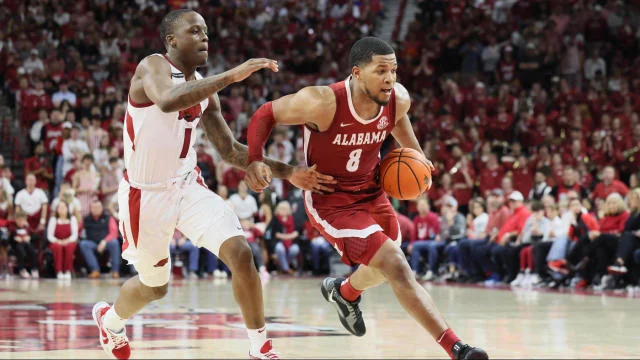When comparing college basketball programs like Alabama and Duke, it is essential to examine various statistics that help us understand the strengths and weaknesses of each team. Among the numerous factors that can be analyzed, there are two key statistical categories where Alabama holds a significant advantage over Duke: scoring efficiency and defensive prowess. These statistics not only highlight the comparative strengths of these teams but also underscore their contrasting styles of play.
To better understand the significance of these differences, we will dive deeper into both stats, how they reflect each team’s game plan, and what implications they have for success at the highest level of college basketball.
1. Scoring Efficiency: Alabama’s Offensive Power
Scoring efficiency is a critical metric in basketball that reflects how effectively a team is able to convert its offensive opportunities into points. In the context of NCAA basketball, it’s often measured by effective field goal percentage (eFG%), which takes into account the value of three-point shots and traditional two-point shots. A high eFG% indicates a team is not only shooting well but also maximizing its scoring opportunities. For teams like Alabama, which rely on fast-paced, high-volume offenses, scoring efficiency becomes even more crucial.
Alabama’s Scoring Efficiency: A Detailed Look
Under head coach Nate Oats, Alabama has become known for its up-tempo style of play, which often leads to quick transitions and three-point shooting. The team has embraced the “space and pace” approach, which allows them to create open looks from beyond the arc and exploit mismatches on the court. This offensive strategy has propelled Alabama to a significant advantage over Duke in the realm of scoring efficiency.
As of the 2024 season, Alabama ranks among the top teams in NCAA basketball in both effective field goal percentage (eFG%) and points per possession (PPP). This high scoring efficiency is a testament to the team’s ability to quickly transition from defense to offense, utilizing their athleticism and shooting prowess to generate open shots. Additionally, the team’s offensive system is designed to create high-quality scoring opportunities by spacing the floor and emphasizing ball movement.
One of the standout features of Alabama’s offense is its three-point shooting. The team has consistently ranked in the top 10 nationally for three-point attempts and conversions, and this perimeter game has been a key driver of their overall offensive efficiency. With players like Brandon Miller and Mark Sears, Alabama has the ability to stretch defenses and force opponents to defend the entire floor. The result is a team that is not only able to score in transition but also capitalize on half-court offensive sets.
Comparing Alabama and Duke’s Scoring Efficiency
Duke, on the other hand, has historically relied more on an inside-out approach with an emphasis on post play and rebounding. While the Blue Devils have certainly adapted to modern basketball by incorporating more three-point shooting, their offense has often been built around traditional power forwards and centers. Consequently, Duke’s scoring efficiency, while still impressive, typically lags behind teams that prioritize perimeter shooting and transition play.
While Duke’s effective field goal percentage has improved in recent years, the team’s shooting selection and shot-making ability from beyond the arc has been inconsistent. The Blue Devils tend to rely on their size and physicality to score inside the paint, which, while effective, is not always as efficient as the fast-paced, three-point heavy strategy that Alabama employs. Moreover, Duke has historically faced challenges in spreading the floor as effectively as teams like Alabama, which can often result in tougher contested shots and lower shooting percentages.
In terms of raw numbers, Alabama often outpaces Duke in scoring efficiency metrics. Alabama’s offense not only generates more points per possession but does so with a more diversified attack that includes both three-point shooting and fast-break opportunities. Conversely, Duke’s reliance on inside scoring means they often have fewer high-value shot attempts from beyond the arc, which can limit their overall scoring efficiency when compared to Alabama.
2. Defensive Prowess: Alabama’s Defensive Dominance
While scoring efficiency is a key indicator of offensive success, defensive efficiency is perhaps the most telling stat in terms of a team’s ability to limit their opponents’ offensive production. Defensive efficiency measures how well a team prevents its opponents from scoring by calculating points allowed per 100 possessions. In this category, Alabama’s defense stands out as one of the top units in the nation, providing them with a significant edge over Duke.
Alabama’s Defensive Advantage
Under Coach Oats, Alabama has transformed itself into one of the premier defensive teams in college basketball. While the team’s offensive efficiency grabs most of the headlines, their defense is equally as effective in limiting opposing teams. A significant factor in Alabama’s defensive success is their ability to pressure the ball and force turnovers. The team’s aggressive full-court press and constant defensive rotations make it difficult for opponents to set up efficient offensive plays.
Alabama’s defense is built around a deep and athletic roster, allowing them to switch across positions and contest shots effectively. With players like Noah Clowney and Jaden Bradley, Alabama has the versatility to defend both inside and on the perimeter. Their length and quickness help them contest shots at the rim while simultaneously forcing tough, contested three-point attempts. This well-rounded defensive strategy not only stifles opposing offenses but also creates easy transition opportunities on the offensive end.
Moreover, Alabama’s defensive metrics reflect their ability to limit high-value shots. The team ranks highly in defending the three-point line, forcing opponents to shoot below their season averages from beyond the arc. Additionally, Alabama’s rim protection has been outstanding, with players like Charles Bediako providing a strong presence in the paint and deterring drives to the basket.
Duke’s Defensive Approach: A Contrast to Alabama’s
Duke’s defense has traditionally been one of the program’s strengths, especially under legendary coach Mike Krzyzewski. The Blue Devils are known for their disciplined, fundamental approach to defense, focusing on team defense, help rotations, and rebounding. However, while Duke’s defense is certainly elite, it tends to operate in a more traditional manner, relying on its size and length to stifle opponents rather than the all-encompassing, ball-pressure style seen at Alabama.
Duke’s defense is often more focused on protecting the paint, with the team’s big men playing an essential role in defending the rim. This focus on interior defense has helped Duke maintain a solid defensive efficiency rating over the years, but it leaves them more vulnerable to teams that excel in perimeter shooting or fast-paced offensive schemes.
In terms of statistical comparisons, Alabama generally excels in defensive efficiency over Duke due to their ability to disrupt passing lanes, force turnovers, and close out on shooters effectively. Additionally, Alabama’s ability to defend without fouling and generate easy offense off turnovers is a crucial advantage that gives them the upper hand over Duke in this area. While Duke has a formidable defense, Alabama’s pressure and defensive depth make them more challenging to score against, especially in a high-paced game where turnovers and fast breaks are common.
Why These Stats Matter for Both Teams
For Alabama, the combination of high offensive efficiency and elite defensive play provides them with a well-rounded, balanced team that is capable of competing at the highest level of college basketball. The Crimson Tide’s ability to efficiently score while also limiting opposing offenses is a hallmark of championship-caliber teams.
On the other hand, Duke’s more traditional approach to basketball—emphasizing physicality, interior scoring, and disciplined defense—has its own strengths. However, when compared to Alabama’s statistical advantages in scoring efficiency and defensive prowess, Duke may find itself at a disadvantage in certain matchups, particularly against teams that play at a fast tempo or rely heavily on three-point shooting.
In the modern landscape of college basketball, where pace and spacing are increasingly important, Alabama’s statistical advantages in scoring efficiency and defense provide them with a distinct edge over Duke. While both teams are elite programs with rich histories and impressive talent, Alabama’s ability to score efficiently and defend at an elite level positions them as one of the most well-rounded teams in the nation.



